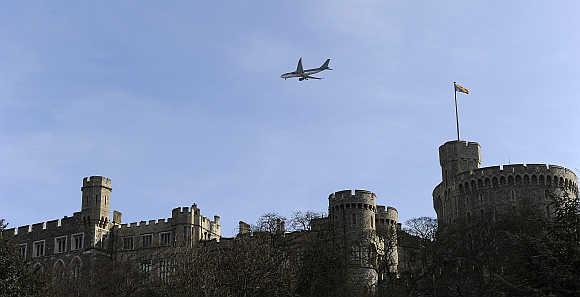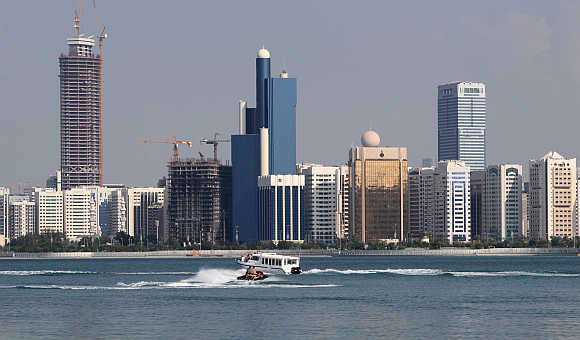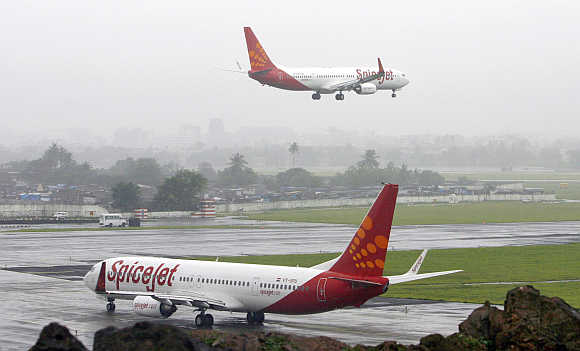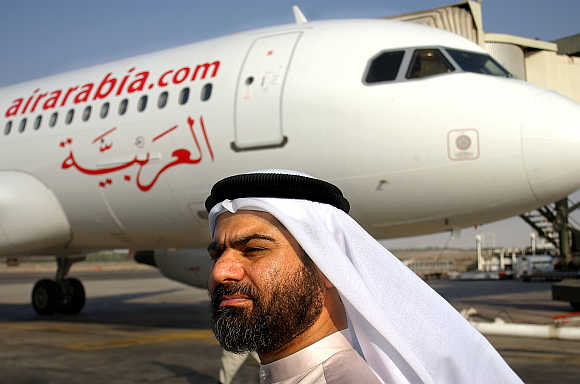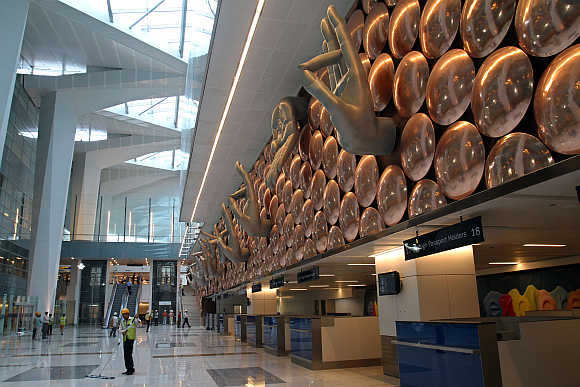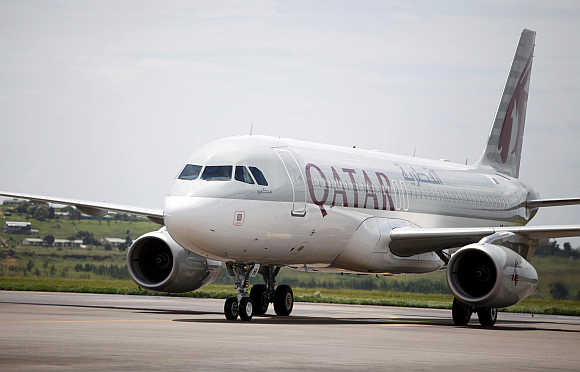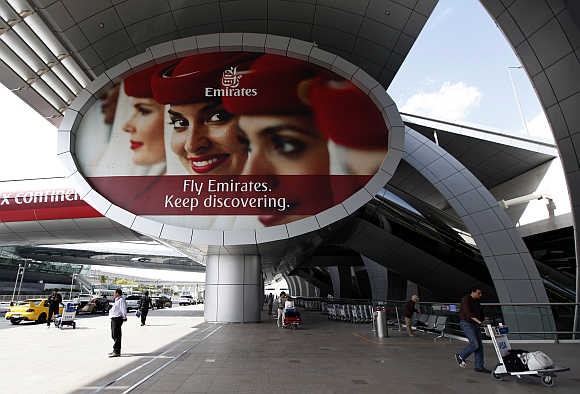 | « Back to article | Print this article |
Indian low-cost carriers sniff opportunity in Gulf
A few weeks ago, Kerala Chief Minister Oommen Chandy stunned the aviation world in India when he announced the launch of Air Kerala, a state government-owned airline, to fly to the Gulf.
This was seen largely as a reaction to an increase in air fares on those routes, and to Air India Express diverting its planes from the Gulf routes to cater to the Haj traffic.
No one knows whether the plan has any teeth to it. Indeed, the Ministry of Civil Aviation hasn't yet received any formal application from the state.
Click NEXT to read more...
Indian low-cost carriers sniff opportunity in Gulf
However, what the entire incident did was drawing attention to the increasingly booming business in the Gulf routes and some of the cash-generating airlines that fly those.
According to the International Air Transport Association's July 2012 data, "The Middle East (or West Asian) carriers experienced the strongest traffic growth, at 11.2 per cent year-over-year, although this was surpassed by a 12.4 per cent rise in capacity."
These kinds of numbers are no doubt helped by the fact that India has signed three bilateral pacts with the United Arab Emirates (UAE) - specifically, Dubai, Abu Dhabi and Sharjah.
Click NEXT to read more...
Indian low-cost carriers sniff opportunity in Gulf
With Sharjah alone, India's treaty allows for around 17,800 seats on a weekly basis. All the airlines from the UAE have above 95 per cent utilisation of their bilaterals.
Air India Express, which offers around 100 flights a week to West Asia, has been the traditional carrier dominating this route, but, it now requires around 200 pilots to ensure smooth operations and an increase in its fleet utilisation to be able to fly the six-hours-a-day today to 12-hours-a-day in order to cater to the increased demand - something it is simply unable to do.
Click NEXT to read more...
Indian low-cost carriers sniff opportunity in Gulf
This has opened up the runways for other airlines, such as flydubai, a low-cost carrier from Dubai, to move in on the action. The airline began its operations in 2010 and operates from just three destinations - Lucknow, Hyderabad and Ahmedabad to Dubai.
There's a reason for the low number of cities it flies from.
"Flydubai has to share bilaterals with Emirates and both carriers fly out of Dubai. Now, since the Indian government offers no more seats to Gulf carriers, flydubai's operations are confined to three destinations," says an LCC's top executive in India.
Click NEXT to read more...
Indian low-cost carriers sniff opportunity in Gulf
Sensing the opportunity in this highly-trafficked space, Indian LCCs like SpiceJet and IndiGo have also dived in to the fray. SpiceJet started its operations to Dubai in June this year with 14 weekly flights. IndiGo has also started 42 weekly flights to Dubai. In totality, there are 156 weekly flights from Indian low-cost carriers to the Gulf.
However, the airline to beat in this sector, and one that can offer a few lessons to Indian LCCs, is Air Arabia, the Middle East (West Asia) and North Africa's first LCC, that Adel Ali, a veteran in the airline business and currently the airline's CEO, helped set up.
Click NEXT to read more...
Indian low-cost carriers sniff opportunity in Gulf
Adel previously served as the vice- president (commercial and customer service) of Gulf Air, where he played a pivotal role in the airline's recovery. Before that, he spent over 20 years with British Airways where he was general manager (Middle East and Africa).
Having started commercial operations in 2003, Air Arabia achieved financial break-even from its very first year of flying and has been profitable ever since - a remarkable feat that very few airlines in the world can match.
In the second quarter of this year, Air Arabia reported a net profit of 66 million dirhams (about Rs 95 crore), an increase of 31 per cent, compared to 51 dirham million (about Rs 73 crore) in the corresponding period in 2011.
Click NEXT to read more...
Indian low-cost carriers sniff opportunity in Gulf
"The West Asian LCCs are offering serious competition to Indian carriers as the Indian ones are not keeping pace with the growth in market size," says Keyur Joshi of Makemytrip.com.
In India, Air Arabia started operations from Nagpur in October 2005 and currently operates 112 weekly flights from its hub in Sharjah to 13 destinations in India.
Air Arabia has focused on tier-II cities in India. In addition to large cities like Mumbai, New Delhi and Chennai, Air Arabia operates services to smaller cities such as Nagpur, Jaipur, Ahmedabad, Cochin, Coimbatore and Trivandrum, making it easier for airlines' customers to fly to their destinations directly from their home town.
Click NEXT to read more...
Indian low-cost carriers sniff opportunity in Gulf
The airline enjoys passenger load factors of over 85 per cent and is the only international carrier from Sharjah to India, and thus enjoys all the bilaterals between the two destinations.
An immediate reason that pops into one's mind for the rising popularity in Gulf routes is workers, largely from Kerala, who fly to the region in droves to work in the infrastructure sector as labourers.
While that is true, it only offers a sliver of an analysis of why West Asian airlines are enjoying their day in the sun.
Click NEXT to read more...
Indian low-cost carriers sniff opportunity in Gulf
One of the big reasons for the rise of the Gulf LCC, according to the Centre for Asia Pacific Aviation, is because the larger Gulf carriers - like Emirates, Qatar Airways and Etihad - have decided to switch their focus to North American markets, the least served region in their network, due to having operated largely in Europe, Asia and Africa in the last few years.
Ajay Prakash, the former president of the Travel Agents Federation of India) says, "With the full- service carriers of West Asia operating in India for quite some time, there is capacity and a lot of opportunities. There is now a lot of growth in traffic and mobility of people to West Asia. These LCCs are now piggy backing on the development of these routes."
Click NEXT to read more...
Indian low-cost carriers sniff opportunity in Gulf
Plus, LCC market penetration in West Asia is still low. So, there is plenty of room for growth and Arab intra-regional traffic shows increasing demand for air travel as local economies develop, CAPA's analysis added.
"While traditional carriers continue to play a vital role in connecting wider continents together and filling up existing demand for long-haul flights, we are confident that low-cost carriers are perfectly situated to efficiently cater to the short- and medium- haul air travel, which represents a huge opportunity in this part of the world," adds Ali of Air Arabia.
Click NEXT to read more...
Indian low-cost carriers sniff opportunity in Gulf
Also, distances within West Asia, to Dubai and other destinations, are covered in a short span of an hour or so, by cab or by using public transport.
Their aggressive pricing and direct connectivity to Sharjah makes them the most attractive for price-sensitive customers like students, contract labourers, and leisure travellers out for a shopping trip.
"Sharjah International Airport is Air Arabia's main hub, because it is ideally situated for travellers with arrival and departure formalities completed in 20 minutes and a variety of transportation facilities are available.
"The airport is just 10 kilometres away from the Sharjah City Center and 15 kilometres from Dubai, and connected by one of the most advanced road networks in the country," says Ali.
Click NEXT to read more...
Indian low-cost carriers sniff opportunity in Gulf
The airport complements the service Air Arabia offers by offering flexible and affordable travel to customers in more than 55 destinations from its Sharjah hub, as well as offering a unique connecting service to travellers looking to reach the Indian subcontinent or Eastern Europe from the Gulf Cooperation Council region via Sharjah airport, he adds.
Obtaining visas for countries is always a headache - if not a nightmare - for many Indians. But these West Asian LCCs are taking the pain out of a West Asia trip by providing one to their flyers.
Click NEXT to read more...
Indian low-cost carriers sniff opportunity in Gulf
There's precedence for this, though. A few years back, a visa for West Asia had to be arranged through a sponsor.
The full-service carriers from West Asia (Emirates, Qatar Airways and Etihad) made this experience easier and started providing visas, and now these LCCs are following suit.
Now, if only Air India Express could do the same.
